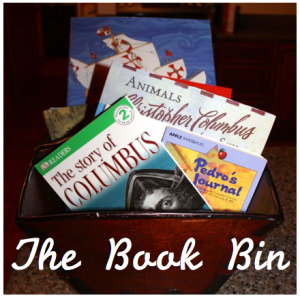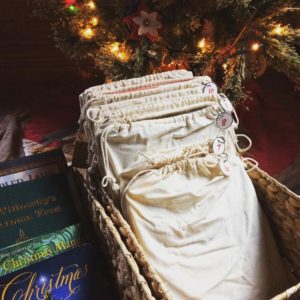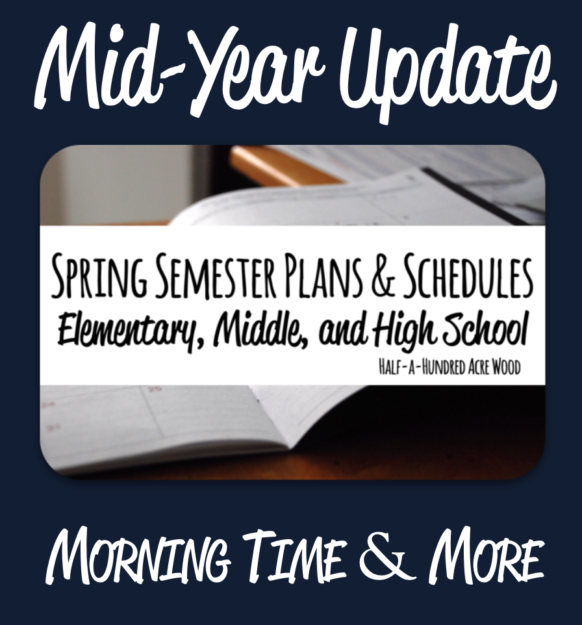
“A generation after their arrival, a perennial problem confronted the Puritans. Christian parents don’t always produce Christian children.” – excerpt from Christian History Made Easy
I came across this quote last night, and it just struck me. It’s something I know and acknowledge generally but not specifically. When I read scripture, it never occurs to me that maybe my child may end up being the prodigal. Now that our oldest is in college, I realize even more that he has to make mistakes. He’ll make some poor choices. (We all do.) And I cannot save him. Only Jesus can. His faith has to be his own. And so is the case with every single person on the planet.
So my question is…. what if? What if we pursue Christ will all that we are, teach our children the way they should go, love the Lord with our heart, soul, mind, and strength, and live lives of sacrifice and service for God, and they choose a different path? Does it change our faith? Or do we remain steadfast with our identity solely in Christ and not in the doing?
Ultimately, we do what we do because Christ tells us to, not because of what we think the outcome will be. Our job is to fulfill the tasks that God gives us to the best of our ability in the strength of Christ. The results are up to God.
This is yet another exercise in faith. (And an exercise in prayer!)
With this in mind, I mention mid-year adjustments and spring semester plans simply to share a mid-year peek into our family morning time, our curriculum choices at each level, and example schedules along with some adjustments and why we’re making them, all with the hope that it will somehow be helpful to another family.
(By the way, another lesson learned is that it’s possible to graduate from high school with an associates degree. Curious to hear more? If so, let us know, and we’ll share more about it in the coming weeks. Until then, check out Homeschooling for College Credit .)
Literature Selections
We’ll start with our favorite: sharing stories together as a family! These read-alouds are part of the alternate plan for our Mission: World Wonders study. This collection of biographies provides a glimpse of how God has used willing vessels to extend love and compassion to people in different cultures and in different circumstances throughout the world.
Family Read Alouds – World Cultures, World Religions, World Missions(Africa, Asia, and Americas)
We’ve studied history, religion, cultures, and geography through inspiring true stories of missionaries, and I can’t tell you how much these stories have impacted our lives!
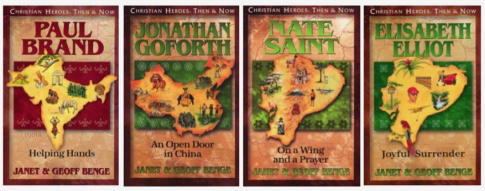
- Paul Brand: Helping Hands (Missionary to India).
- Jonathan Goforth: An Open Door in China (Missionary to China).
- Nate Saint: On a Wing and a Prayer (Missionary to Central & South America).
- Elisabeth Elliot: Joyful Surrender (Missionary to Ecuador).
Our family read-alouds are taken from our Mission: World Wonders Trip #2 plans. If you happen to know a family using Classical Conversations, the books above would be great to read during Cycle 1. Over the course of the year, we also add in lots of other books as read-alouds. Check out what we read together in 2021 (almost all of which I would highly recommend to others)!
High School Literature Selections – World History/Literature
Because our second son is aiming to work towards his associates degree as he completes high school, our history and literature selections have shifted mid-year. For the remainder of this school year, literature selections for our high school student will roughly follow Notgrass Exploring World History, but we’ll remain flexible on these selections since he’ll be reviewing/studying for the American Literature CLEP. (He studied American literature last year but needs to refresh now that we have a CLEP plan in place.)
Instead of using regular comprehension literature guides, our family’s literature discussions follow the Teaching the Classics Approach. (We highly recommend Teaching the Classics for parents to learn how to discuss literature with their children!) Our children will be filling out a story chart for each work of literature this year while also practicing the art of narration.
- Screwtape Letters by C.S. Lewis
- Julius Caesar by William Shakespeare
- Here I Stand by Roland H. Bainton
- A Tale of Two Cities by Charles Dickens
- North and South by
- Bridge to the Sun by Gwen Terasaki
- Cry, the Beloved Country by Alan Paton
- The Abolition of Man by C.S. Lewis
- Through Gates of Splendor or Shadow of the Almighty by Elisabeth Elliot
Middle School Literature Selections – Fall of Rome through the Renaissance
Our middle-schooler’s literature selections will correspond roughly to history assigned in Mission: World Wonders (which is Story of the World Volume 2 for this semester).
In most cases, he will be spending 3 weeks on each book.
- King Arthur and his Knights of the Round Table by Roger Lancelyn Green
- A Single Shard by Linda Sue Park
- The Adventures of Robin Hood by Roger Lancelyn Green
- The Hobbit by J. R. R. Tolkien
- The King’s Fifth by Scott O’Dell
- Tales from Shakespeare by Tina Packer. To end the year, we just wanted a quick, simple summary of 10 of Shakespeare’s works which we’ll be exploring in greater detail in years to come. This book is a family favorite but is out-of-print. Another favorite (with summaries of all of Shakespeare’s plays) is The Usborne Complete Shakespeare.
Again, instead of using literature guides, our family discussions follow the Teaching the Classics Approach. (We highly recommend Teaching the Classics for parents to learn how to discuss literature with their children!)
Lower Elementary Literature Selections
Because our 2nd grader is not yet reading chapter books, we’ll be reading select titles from these World History and Science Leveled Readers, these favorite ancient history picture books, and these favorite middle ages picture books using the “book bin” approach.
At the beginning of each week, I’ll fill a basket full of the books that we’re planning to read that week. For greater anticipation, we may store them in bags as we do for our Christmas book countdown!
Curriculum Choices: Elementary through High School
Over the past three years, we’ve enjoyed connecting as a family in a unified learning experience through our morning time. We all start together with morning time which takes about an hour, part of which is over breakfast. This is our most special time, and our teenagers love to be a part of it. After that, our older students are fairly independent in their individual work and just ask questions as they need my assistance. After morning time, most of my day is spent on teaching reading, writing, and arithmetic (2nd grader), formal writing/editing (7th & 10th grader), and literature/history discussions (everyone).
Family Morning Time = Family Togetherness Time
Our family morning time begins with Mission: World Wonders which covers missions, history, world geography/cultures, science, and fine arts using our favorite curriculum choices for these subjects. 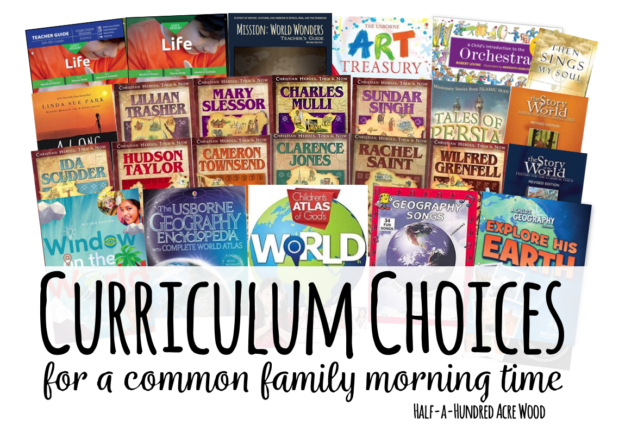
We’ve included a few reasons why we’ve picked each resource below.
- For geography, The Usborne Geography Encyclopedia, Children’s Atlas of God’s World, Geography Audio Memory CD, and Window on the World. These books are our favorite geography resources which we use over a two-year period.
- For science, we’re using Our Planet Earth from God’s Design for Heaven & Earth while also finishing up The World of Animals from God’s Design for Life. We enjoy the Answers in Genesis God’s Design series because it is one of the simplest science programs to implement. It uses a hands-on approach to learning, the readings take less than 10 minutes, the experiments mostly use common household items, nature study is encouraged/incorporated, and the books include color illustrations and photos. Recently, Answers in Genesis stopped publishing the individual titles, so they are now only available as the triple-volume sets published by Masterbooks, which we carry in our store.
- For history, we’re heading into The Story of the World Volume 2 after finishing Volume 1 first semester. Over our years of homeschooling, we’ve reviewed and/or used other history programs (including The Mystery of History, The World’s Story, From Adam to Us, and Diana Waring’s History Revealed) but we’ve kept returning to The Story of the World because of its narrative quality and ease of use. It has not only been the best history for providing cultural stories from around the world, it also introduces some epic ancient literature in a safe way, making it possible to skip certain pagan literature later in middle or high school (if you choose to do so) while still providing background on these stories and their impact on civilizations. And… it is one of the few programs that includes an audiobook option making it easier for homeschooling families to implement.
- For fine arts, we use The Usborne Art Treasury for full-color, step-by-step art projects (alongside famous artist study), Then Sings My Soul for hymn study, and A Child’s Introduction to the Orchestra for classical music and orchestra/composer study. These have been absolute favorites in our home!
- For additional Bible study, we’re reading The Child’s Story Bible by Catherine Vos along with The Greenleaf Guide to Old Testament History.
If you want to see what Mission World Wonders is like in action, see the lower part of this post that includes photos and details about science, art, and other activities.
Many of the resources below are part of the Compass Classroom Membership, a monthly subscription option allowing homeschool families access to dozens of courses. You can test drive all the courses for free here!
High School (Grade 10)
- Bible (1 credit) – The Greenleaf Guide to Old Testament History (family discussion during morning time)
- Lab Science (1 credit) – Exploring Creation with Physical Science – 2nd Edition. We prefer the older edition of Exploring Creation with Physical Science.
- Foreign Language (1 credit) – Visual Latin II | Download 2 Free Lessons. You can read more about why we love Visual Latin here.
- Using this in conjunction with Lingua Latina and the Lingua Latina Companion
- Math (1 credit) – Math U See Geometry (Although we loved Jacobs Geometry for our oldest, Math U See will be a better fit for our second son.)
- CHANGE to PLAN. World History (1 credit) – Although we love Dave Raymond’s history, some of our goals (and thus curriculum choices) are shifting because our second oldest son is aiming to work towards his associates degree as he completes high school. For the remainder of the year, he’s using Notgrass Exploring World History, a single curriculum that can provide a full high school credit in World History, English, and Bible.
- CHANGE TO PLAN. English Composition (1 credit) – David completed Creative Writing with Jonathan Rogers during the fall semester and LOVED-LOVED-LOVED it! (Click on the sample lessons tab to view the first two lessons of each course – Writing through the Wardrobe, Writing with Hobbits, Writing with the Bog Owl, and Writing through To Kill a Mockingbird). Originally for second semester, we were planning on diving into Rhetoric with Fitting Words (which you can read about here), but instead we’re using Windows to the World, an introduction to literary analysis that teaches high school students how to analyze elements of literature: setting, plot, characterization, imagery, allusions, parallelism, and more, as he also reviews/studies for the American Literature CLEP exam. We’ll dive into Rhetoric with Fitting Words during his junior or senior year.
- CHANGE TO PLAN. Visual Arts (1 credit) – Filmmaking from the First Directors. Our second son has enjoyed working in video and scripting with this course, but we’re setting it aside until the summer when it will be easier to record exterior shots. (This also provides more time in his schedule for ACT and CLEP test prep.)
- Literature Selections (mentioned above)
Middle School (Grade 7)
Our 7th grader’s science, geography, and history work are taken primarily from Mission: World Wonders. Other subjects we incorporate at this level are Latin, Logic, English Composition, and Math.
- World History – Story of the World Volume 2: The Middle Ages (From the Fall of Rome to the Rise of the Renaissance) as assigned in Mission World Wonders.
- Bible – The Greenleaf Guide to Old Testament History (family discussion during morning time)
- Science – Mission World Wonders – Our Planet Earth from God’s Design for Heaven & Earth
- Foreign Language – Visual Latin I | Download 2 Free Lessons. Our third son will complete Visual Latin during middle school before heading into Spanish in high school. (He has wanted to work in construction since age 2, so Spanish will be his high school level foreign language.)
- Using this in conjunction with Lingua Latina and the Lingua Latina Companion
- Math – Math U See Prealgebra. Most math programs implement either too few math problems or too many. This one seems to have a good balance, and it’s a math course our son is actually wanting to take. We’ll share more about our experience as the year progresses.
- Logic – Last semester, he finished Fallacy Detective and is following it up with Art of Argument for the remainder of the year.
- Cartography/Geography – Tracing & grid-drawing according to our Mission: World Wonders plan. We will likely use Draw the World and other books from this series to assist with the effort in learning to draw the world freehand from memory.
- CHANGE TO PLAN. English Composition – Levi has done very well in IEW Structure & Style for Students Level B (you can try three weeks free here), but he has reached a stage when it makes sense to teach him how to argue well. We’ll work on argumentative essays for the rest of this semester using select literature along with the invention, arrangement, and elocution steps from The Lost Tools of Writing.
- Literature Selections are mentioned above.
Elementary School (Grade 2)
- Family Morning Time/Mission World Wonders:
- World History (from Mission World Wonders). Story of the World Volume 2: The Middle Ages (From the Fall of Rome to the Rise of the Renaissance) as assigned in Mission World Wonders – and select titles from our favorite middle ages picture books.
- Geography Memory Work (from Mission World Wonders).
- Science (from Mission World Wonders) – God’s Design Series: World of Animals as scheduled in our Mission World Wonders Curriculum Guide and Our Planet Earth from God’s Design for Heaven & Earth.
- Bible: The Child’s Story Bible by Catherine Vos
- All About Reading Level 2. We LOVE All About Reading. (Click here for why.) He’s been re-reading all his Level 1 books this summer, and it’s such a relief that he loves it this much.
- All About Spelling Level 2
- Finish Script-n-Scribe Poetry Penmanship followed by either Truth Traveler or a new Script-n-Scribe book featuring fables or parables. Maybe?
- Math U See Beta. We swapped to Math U See last year and suddenly he started understanding place value. He loves this program, and I love that he loves math now.
- IEW Bible Heroes Writing Lessons (if he’s ready) – Includes free Teacher Edition ebook
- Literature selections (will write in which books we read each week from our favorite middle ages picture books)
It’s important to note that we don’t become slaves to a curriculum but use the curriculum as a tool for learning. (You are master over the curriculum. Not the other way around.) With that in mind, our curriculum choices and schedules are subject to change if we find that a particular resource is not fulfilling its purpose.
And… although it’s not written into the schedule, hobbies, chores, and play are all a part of our normal everyday routine.
Sample Homeschool Schedules
I thought I’d wrap this up by including a sample schedule here for the sake of others who would like to see a schedule. Our actual schedule deviates from this quite a bit for our older children. The only thing that remains consistent for everyone is our family morning time. Our older students choose the order in which they complete assignments, so one may be working on math while another is working on Latin. When I’m working with a student on writing/editing, his brothers are working on something they can do without my assistance so that they don’t interrupt.
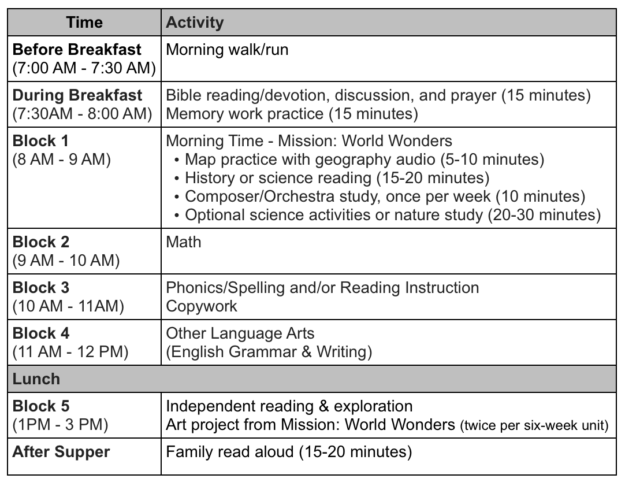
In a more simplistic format, here’s a rundown of what our core, bare-bones schedule sort of looks like (but Block 1 consists of our Mission World Wonders Morning Time instead of just Memory work and maps).

If you have any questions about this schedule, about any of our curriculum choices or literature selections, about homeschooling high school, or about homeschool planning in general, feel free to give us a shout!
[I am] confident of this very thing, that he which has begun a good work in you will perform it until the day of Jesus Christ: -Philippians 1:6
This post was originally published in December 2021.

